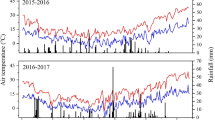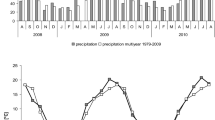Abstract
Oilseed rape (Brassica napus L.) is one of the most important oilseed crops in temperate climates. Erysiphe cruciferarum is an important disease of oilseed rape and causes crop loss in warmer areas of Europe. The research investigated the effect of nitrogen fertilizer and fungicidal treatment against powdery mildew infection caused by E. cruciferarum of oilseed rape on seed components, including protein, oil, oleic acid, linolenic acid and undesirable substances such as sinapic acid esters (SAE) and glucosinolates (GSL), using near infrared spectroscopy (NIRS). Five susceptible oilseed rape varieties were employed in this research using four treatment groups: no nitrogen fertilization and no fungicidal treatment (N0–F0); no nitrogen fertilization but fungicidal treatment (N0–F1); and nitrogen fertilization but no fungicidal treatment (N1–F0); nitrogen fertilization and fungicidal treatment (N1–F1). Nitrogen fertilization increased the protein, but lowered the oil content, of the seeds. Fungicidal treatments significantly increased oil contents in all varieties tested, however reduced protein levels in fertilized and non-fertilized plots. The level of linolenic acid did not change significantly in any plots of any treatment combinations; a similar result was observed in the level of oleic acid in most of the genotypes. Nitrogen fertilization increased GSL and SAE levels, whereas fungicidal treatment had no effect. Our findings demonstrated that nitrogen fertilization can markedly influence some quality parameters in oilseed rape; however, the application of fungicides reduced side effects of nitrogen fertilizer and resulted a reduction on GSL, SAE and protein contents but an increase on total oil and oleic acid contents.
Similar content being viewed by others
References
Fried W, Baetzel R, Badani AG, Koch M, Schimdt R, Horn R, Lühs W. Züchtung auf optimierte Schrotqualitaet bei Raps (Brassica napus). Vortraege Pflanzenzüchtung. 2002;54:131–43.
Schierholt A. Hoher Ölsäuregehalt im Samenöl: Genetische Charakterisierung von Mutanten im Winterraps (Brassica napus). PhD Dissertation. Cuvlillier, University of Geottingen, 2000.
Miller JF, Zimmermann DC, Vick BA. Genetic control of high oleic acid content in sunflower oil. Crop Sci. 1987;27:923–6.
Scarth R, McVetty PM. Designer oil canola—a review of new food-grade Brassica oils with a focus on high oleic, low linolenic types. In: Proceedings of the 10th International Rapeseed Congress, Canberra, 1999 (CD-ROM).
Harbone JB. Plant phenolics. In: Bell, Charlwood BV, editors. Sacondary plant products. Encyclopedia of plant physiology. Vol. 8. Berlin-Heidelberg: Springer-Verlag; 1980. p. 329–402.
Kozlowska H, Naczk M, Shahidi F, Zadernowski R. Phenolic acids and tannins in rapeseed and canola. In: Shahidi F, editor. Canola and rapeseed: production, chemistry, nutrition and processing technology. New York: Van Nostrand Reinhold; 1990. p. 193–210.
Panford JA, De Man JM. Determination of oil content of seeds by NIRS: influence of fatty acid composition on wavelength selection. J. Am. Oil Chem. Soc. 1990;67:473–82.
Velasco L, Fernández-Mártinez JM, De Haro A. Use of near infrared reflectance spectroscopy to screen Ethiopian mustard for seed weight. Agron. J. 1997;89:150–3.
Tkackuk R. Oil and protein analysis of whole rapeseed kernels by near-infrared reflectance spectroscopy. J. Am. Oil Chem. Soc. 1981;58:819–22.
Velasco L, Matthäus B, Möller C. Nondestructive assessment of sinapic acid esters in Brassica species: I. Analysis by near infrared reflectance spectroscopy. Crop Sci. 1998;38:1645–50.
Velasco L, Möller C. Nondestructive assessment of sinapic acid esters in Brassica species: II. Evaluation of germplasm and identification of phenotypes with reduced levels. Crop Sci. 1998;38:1650–4.
Penaud A. Les nouvelles maladies du colza. Phytoma 1991;427:15–18.
Penaud A. Chemical control and yield losses caused by Erysiphe cruciferarum on oilseed rape in France. In: Proceedings of the 10th international rapeseed congress, Canberra, 1999 (CD-ROM).
Mika V, Tillmann P, Koprna R, Nerusil P, Kucera V. Fast prediction of quality parameters in whole seeds of oilseed rape (Brassica napus L.). Plant Soil Environ. 2003;49:141–5.
Gül MK. QTL-Kartierung und Analyse von QTL X Stickstoff Interaktionen beim Winterraps (Brassica napus L.). PhD Dissertation. Cuvlillier, University of Geottingen, 2002.
Auld DL, Heikkinen MK, Erickson DA, Sernyk JL, Romero JE. Rapeseed mutants with reduced level of polyunsaturated fatty acids and increased levels of oleic acid. Crop Sci. 1992;32:657–62.
Möller C, Rücker B, Stelling D, Schierholt A. In vitro selection for oleic and linoleic acid content in segregating populations of microspore derived embryos of Brassica napus. Euphytica 2000;112:195–201.
Röbbelen G, Kräling K. Rapeseed oils high in single fatty acid contents for oleochemical uses. Ind. Crops Prod. 1993;1:303–9.
Kutcher HR, Malhi SS, Gill KS. Topography and management of nitrogen and fungicide affects diseases and productivity of canola. Agron. J. 2005;97(2):533–41.
Becker HC, Löptien H, Röbbelen G. Breeding: an overview. In: Gòmez-Campo C, editor. Biology of brassica coenospecies. Amsterdam: Elsevier; 1999. p. 413–60.
Butkute B., Masauskiene A, Sidlauskas G, Slesaraviciene L. The effectf agronomic factors and growth conditions on protein and fat content in the seed of pring oilseed rape and on the variation of fatty acids. Agriculture. 2000;70:160–75.
Brandt SA, Malhi SS, Ulrich D, Lafond GR, Kutcher HR, Johnston AM. Seeding rate, fertilizer level and disease management effects on hybrid versus open pollinated canola (Brassica napus L.). Can. J Plant Sci. 2007;87(2):255–66.
Brar ZS, Bal DS, Johl AS. Influence of sowing dates, nitrogen and planting geometry on the performance of Gobhi Sarson (Brassica napus sp. olifera var. annua). Indian J. Agron. 1998;43:133–7.
Mekki BB. Yield and chemical composition of rapeseed (Brassica napus L.) varities in response to nitrogen fertilization. 3. International rapeseed congress. 6–10 July, Copenhagen. 2003;3:915–17.
Heinz E. Biosynthesis of polyunsaturated fatty acids. In: Moore T, editor. Lipid metabolism in plants. CRC Press; 1993.
McCartney HA, Doughty KJ, Norton G, Booth EJ, Kightley SPJ, Landon G, West G, Walker KC and Thomas JE. Study of the effect of disease on seed quality parameters of oilseed rape. In: Proceedings of the 10th international rapeseed congress, Canberra, Australia. 1999. (CD-ROM).
Butkute B, Sidlauskas G, Brazauskiene I. Seed yield and quality of winter oilseed rape as affected by nitrogen rates, sowing time, and fungicide application. Commun. Soil Sci. Plan. 2006;37(15–20):2725–44.
del Rio LE, Bradley CA, Henson RA, Endres GJ, Hanson BK, Mckay K, Halvorson M, Porter PM, Le Gare DG, Lamey HA. Impact of Sclerotinia stem rot on yield of canola. Plant Dis. 2007;91(2):191–4.
Parry D. Plant pathology in agriculture. Cambridge UK: The University Press; 1990.
Acknowledgement
The authors thank to Prof. Dr. H. Christian Becker and Mrs Sonya Yaman (Goettingen Georg-August University, Institute for Plant Production and Plant Breeding) for their kind help on analyzing the samples.
Author information
Authors and Affiliations
Corresponding author
Rights and permissions
About this article
Cite this article
Mert-Türk, F., GÜL, M.K. & Egesel, C.Ö. Nitrogen and fungicide applications against Erysiphe cruciferarum affect quality components of oilseed rape. Mycopathologia 165, 27–35 (2008). https://doi.org/10.1007/s11046-007-9070-3
Received:
Accepted:
Published:
Issue Date:
DOI: https://doi.org/10.1007/s11046-007-9070-3




